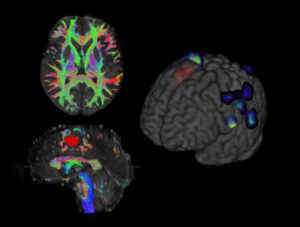
Functional magnetic resonance imaging, or fMRI, is a technique for measuring brain activity.
It works by detecting the changes in blood oxygenation and flow that occur in response to neural activity – when a brain area is more active it consumes more oxygen and to meet this increased demand blood flow increases to the active area.
fMRI can be used to produce activation maps showing which parts of the brain are involved in a particular mental process.

The image shown is the result of the simplest kind of fMRI Visual system experiment. While lying in the MRI scanner the subject watched a screen that alternated between showing a visual stimulus and being dark every 30 second. Meanwhile the MRI scanner tracked the signal throughout the brain. In brain areas responding to the visual stimulus you would expect the signal to go up and down as the stimulus is turned on and off, albeit blurred slightly by the delay in the blood flow response.
As a brain imaging technique FMRI Monitor has several significant advantages:
fMRI stands for functional MRI. It’s a scan that shows which parts of your brain are active by tracking blood flow.
The machine detects changes in blood flow when your brain is working, so it can show which areas are busy during different activities.
Doctors use fMRI to map brain activity, help plan surgeries, and study conditions like epilepsy or stroke.
Yes, it’s just like a regular MRI—no radiation, and it’s safe for most people, but let your doctor know if you have any metal implants.
A regular MRI shows what your brain looks like, while fMRI shows which parts are working when you do things.
You’ll lie still in the machine, and sometimes do simple tasks like tapping your fingers or thinking about something. The scanner records your brain activity.
People who need brain surgery, have neurological issues, or researchers studying how the brain works.
It’s very safe for most people. The only risk is if you have certain implants, so always tell your doctor beforehand.
©2024 Kryptonite SolutionsTM. All Rights Reserved.
Powered by: Purple Tuché